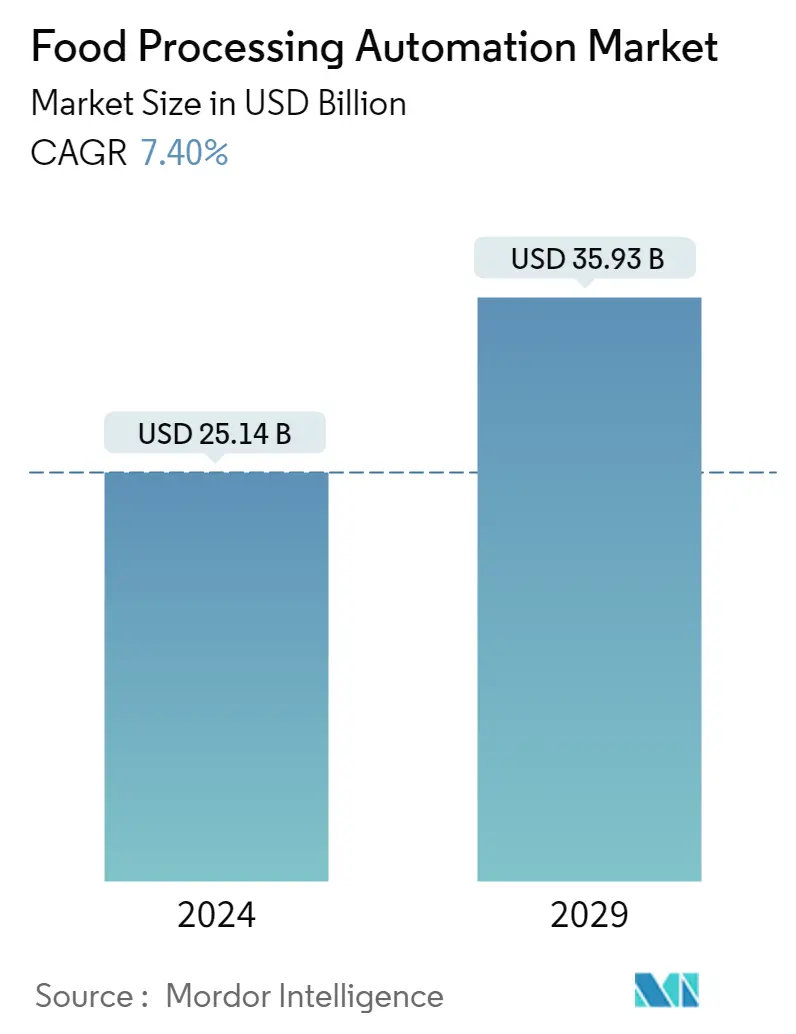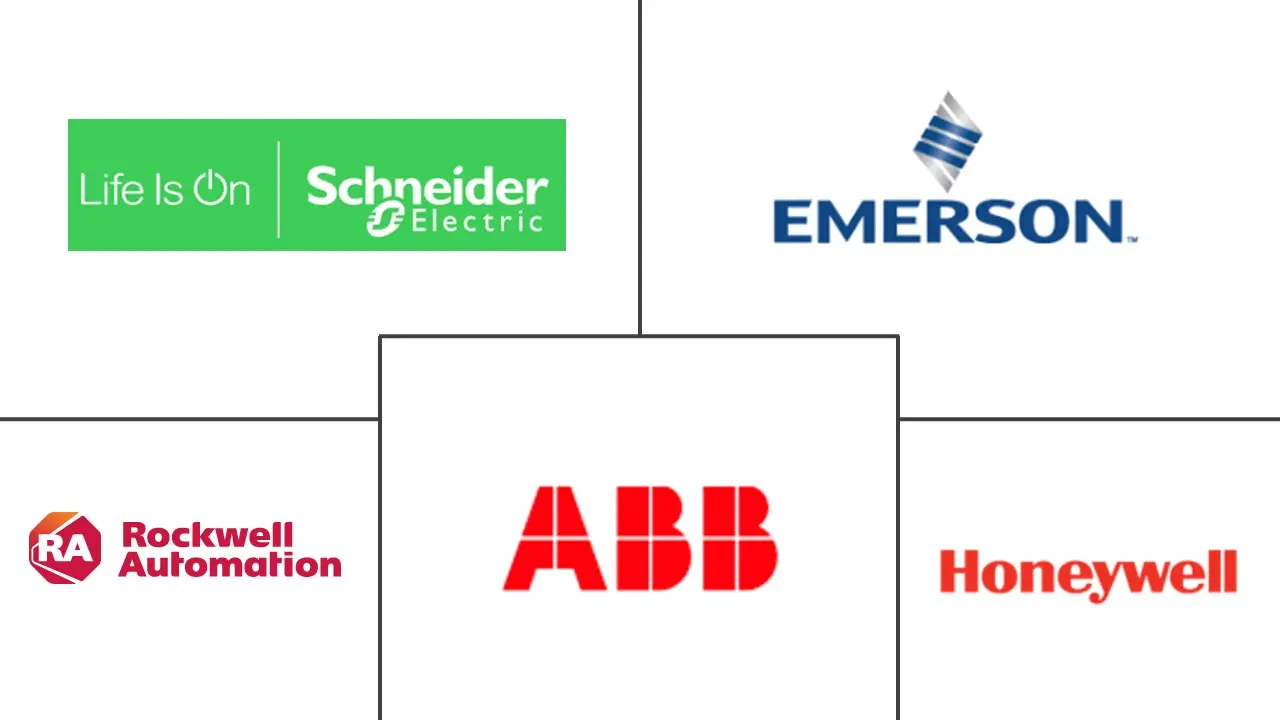Market Size of Food Processing Automation Industry

| Study Period | 2019 - 2029 |
| Market Size (2024) | USD 25.14 Billion |
| Market Size (2029) | USD 35.93 Billion |
| CAGR (2024 - 2029) | 7.40 % |
| Fastest Growing Market | Asia Pacific |
| Largest Market | North America |
Major Players
*Disclaimer: Major Players sorted in no particular order |
Food Automation Market Analysis
The Food Processing Automation Market size is estimated at USD 25.14 billion in 2024, and is expected to reach USD 35.93 billion by 2029, growing at a CAGR of 7.40% during the forecast period (2024-2029).
Automation has been adopted in manufacturing plants for the last 50 years, and it is increasing day by day. The food industry has become one of the fastest-growing segments of plant automation. The food industry is growing tremendously and is one of the major sectors contributing to GDP.
- The demand for processed goods is increasing, with increased buying power and changing lifestyles. This has made it necessary for food manufacturers to implement automation to improve the processing rate to meet consumers' demands. Furthermore, the rapid development of computer technology, dynamic changes in consumers' preferences, and regulatory bodies have boosted the need for food quality and safety. This has resulted in the growing adoption of automated systems in the food industry.
- Automation provides direct and indirect benefits to the production line, including increased waste reduction and speed. Indirect benefits can range from increased workplace safety and precision to longer operational hours at a lower total budget; vendors operating in the market are increasingly focusing on adopting these solutions to drive efficiency and their operational capabilities.
- Food processing has improved the palatability and shelf-life of foods. Processed food items undergo at least some processing and thus include moderately and highly processed foods.
- Advancements in the food processing industry, innovation in processing technology, and continuous growth in the requirement for processed food are expected to support the development of food and beverage processing equipment.
- The installation and acquisition cost of a control system for an intelligent factory represents half of the total cost during its lifetime. Additionally, the frequent changes in networking and technology also result in significant cost increases, which is much more than the initial investment, further restraining the adoption. Even significantly low adoption among SMEs, especially in developing countries, like Brazil, that cannot bear the product costs, is restraining the market's growth.
Food Automation Industry Segmentation
Automation in the food industry simplifies the food packaging process, which includes food sorting and grading, packing, and managing processes. Automation is an effective solution for enterprises requiring an efficient solution for overcoming numerous challenges, such as enhancing productivity, improving yield, optimizing resource management, mitigating security risks, and improving asset management.
The food automation market is segmented by operational technology and software (distributed control systems (DCS), manufacturing execution systems (MES), variable-frequency drive (VFD), valves and actuators, electric motors, sensors and transmitters, and industrial robotics), end user (dairy processing, bakery and confectionery, meat, poultry, and seafood, fruits and vegetables, and beverages), application (packaging and repackaging, palletizing, sorting and grading, and processing), geography (North America (United States and Canada), Europe (United Kingdom, Germany, France, and Rest of Europe), Asia-Pacific (China, India, Japan, and Rest of Asia-Pacific), Latin America, and Middle-East and Africa). The report offers the market size in value terms in USD for all the abovementioned segments.
| By Operational Technology and Software | |
| Distributed Control System (DCS) | |
| Manufacturing Execution Systems (MES) | |
| Variable-frequency Drive (VFD) | |
| Valves and Actuators | |
| Electric Motors | |
| Sensors and Transmitters | |
| Industrial Robotics | |
| Other Technologies |
| By End User | |
| Dairy Processing | |
| Bakery and Confectionary | |
| Meat, Poultry, and Seafood | |
| Fruits and Vegetables | |
| Beverages | |
| Other End Users |
| By Application | |
| Packaging and Repackaging | |
| Palletizing | |
| Sorting and Grading | |
| Processing | |
| Other Applications |
| By Geography | ||||||
| ||||||
| ||||||
| ||||||
| Latin America | ||||||
| Middle East and Africa |
Food Processing Automation Market Size Summary
The food automation market is experiencing significant growth, driven by the increasing demand for processed goods and the need for improved efficiency in food manufacturing. Automation has become a crucial component in the food industry, which is one of the fastest-growing segments of plant automation. The adoption of automated systems is fueled by advancements in computer technology, changing consumer preferences, and the need for enhanced food quality and safety. These systems offer numerous benefits, including waste reduction, increased production speed, and improved workplace safety. The beverage industry, in particular, has been a leading adopter of automation, utilizing robotic solutions to streamline production, packaging, and warehousing processes. The growing consumption of packaged beverages and the expansion of distribution channels further drive the demand for automation in this sector.
In regions like the United States and Canada, the food and beverage industry is witnessing robust growth, prompting companies to transition from manual processing to automated solutions. This shift is supported by factors such as urbanization, health awareness, and increased disposable income. The need for secure and safe food production processes, driven by the rising incidence of foodborne diseases, is also propelling the market. The competitive landscape is marked by the presence of major players who are actively engaging in partnerships, product launches, and technological innovations to enhance their offerings. These developments, along with the continuous growth in the requirement for processed food, are expected to support the market's expansion over the forecast period.
Food Processing Automation Market Size - Table of Contents
-
1. MARKET INSIGHTS
-
1.1 Market Overview
-
1.2 Industry Value Chain Analysis
-
1.3 Industry Attractiveness - Porter's Five Forces Analysis
-
1.3.1 Bargaining Power of Suppliers
-
1.3.2 Bargaining Power of Buyers
-
1.3.3 Threat of New Entrants
-
1.3.4 Threat of Substitute Products and Services
-
1.3.5 Degree of Competition
-
-
1.4 Impact of COVID-19 on the Market
-
-
2. MARKET SEGMENTATION
-
2.1 By Operational Technology and Software
-
2.1.1 Distributed Control System (DCS)
-
2.1.2 Manufacturing Execution Systems (MES)
-
2.1.3 Variable-frequency Drive (VFD)
-
2.1.4 Valves and Actuators
-
2.1.5 Electric Motors
-
2.1.6 Sensors and Transmitters
-
2.1.7 Industrial Robotics
-
2.1.8 Other Technologies
-
-
2.2 By End User
-
2.2.1 Dairy Processing
-
2.2.2 Bakery and Confectionary
-
2.2.3 Meat, Poultry, and Seafood
-
2.2.4 Fruits and Vegetables
-
2.2.5 Beverages
-
2.2.6 Other End Users
-
-
2.3 By Application
-
2.3.1 Packaging and Repackaging
-
2.3.2 Palletizing
-
2.3.3 Sorting and Grading
-
2.3.4 Processing
-
2.3.5 Other Applications
-
-
2.4 By Geography
-
2.4.1 North America
-
2.4.1.1 United States
-
2.4.1.2 Canada
-
-
2.4.2 Europe
-
2.4.2.1 United Kingdom
-
2.4.2.2 Germany
-
2.4.2.3 France
-
-
2.4.3 Asia
-
2.4.3.1 China
-
2.4.3.2 India
-
2.4.3.3 Japan
-
2.4.3.4 Australia and New Zealand
-
-
2.4.4 Latin America
-
2.4.5 Middle East and Africa
-
-
Food Processing Automation Market Size FAQs
How big is the Food Processing Automation Market?
The Food Processing Automation Market size is expected to reach USD 25.14 billion in 2024 and grow at a CAGR of 7.40% to reach USD 35.93 billion by 2029.
What is the current Food Processing Automation Market size?
In 2024, the Food Processing Automation Market size is expected to reach USD 25.14 billion.

